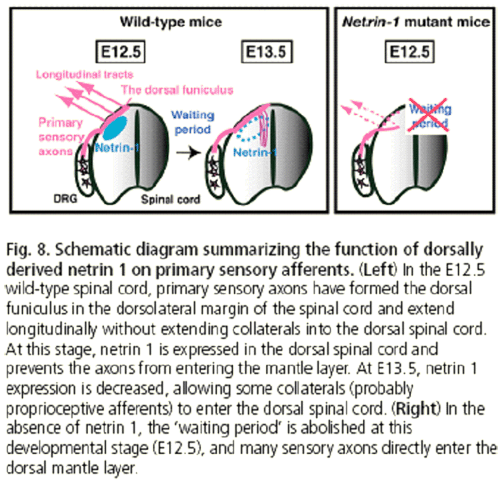Dorsal root ganglion (DRG) neurons extend axons to the specific targets in the gray matter of the spinal cord. During development, DRG axons grow into the dorsolateral margin of the spinal cord, and the projections into the dorsal horn occurs after a "waiting period" of a few days. Guidance molecules involved in sensory axon patterning in the spinal cord are totally unknown. Netrin-1 is a long-range diffusible factor expressed in the ventral midline of the developing neural tube, and has chemoattractive and chemorepulsive effects on growing axons. Netrin-1 is also expressed in the dorsal spinal cord. Here we show that dorsally derived netrin-1 controls the correct guidance of primary sensory axons. During the waiting period, netrin-1 is transiently expressed in the dorsal horn of the cord, and the absence of netrin-1 results in aberrant projections of sensory axons, including both cutaneous and proprioceptive afferents, into the dorsal horn. Netrin-1 derived from the dorsal spinal cord, but not the floor plate is involved in the correct projections of DRG axons. Furthermore, netrin-1 suppresses axon outgrowth from DRG in vitro. This inhibitory effect of netrin-1 on sensory afferents is mediated by Unc5 family receptors, but not Dcc. These results are the first direct evidence that netrin-1 in the dorsal spinal cord acts as an inhibitory cue for primary sensory axons and is a crucial signal for the formation of sensory afferent neural networks.
Watanabe K, Tamamaki N, Furuta T, Ackerman SL, Ikenaka K, Ono K. (2006) Dorsally Derived Netrin-1 Provides an Inhibitory Cue and Elaborates the "Waiting Period" for Primary Sensory Axons in the Developing Spinal Cord. Development, 133 (7): 1379-1386.
